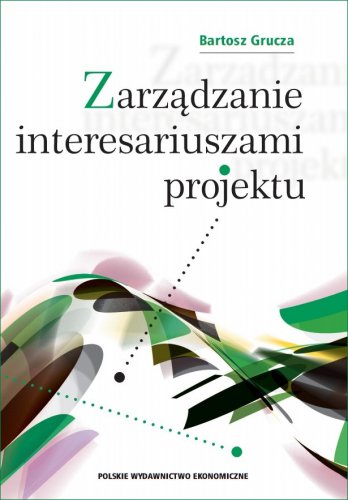Zarządzanie interesariuszami projektu
Publication date: 2019
Place publication: Warszawa
Publication: I
Binding: paperback
Format: B5
The importance of projects in organizations and the economy has certainly increased over a couple of last decades. Allowing some simplification, this phenomenon, consisting in a transition from routine to non-routine processes, has led to significant changes in the way enterprises operate and to a new area of knowledge being distinguished in the form of project management. At present we are witnessing an increasing number of interactions between projects and their environment and various entities involved therein, i.e. their stakeholders. Any project becomes inextricably related with its stakeholders’ behaviors. The concept of stakeholders has become more and more popular among experts in management, due to its pragmatic character, close to practical problems and solutions. Specifically, this concept regards management as a resultant of aspirations, objectives and actions of various groups of interest, which is in line with observations and practical experience. This phenomenon has particular importance in project management.
The monograph addresses the issue of project stakeholders management. The concept of management of project stakeholders is a pragmatic concept, which means that it is not only meant to explain the problems involved in management, but also to help solving the same. As one of its crucial elements, the concept includes the process of management of stakeholders. This usually consists of at least three phase: that of analysis, of planning and of implementation. All three are related with individual processes of project management. The Author developed a proposal of an eight-stage model of the process of involving project stakeholders, which includes as follows: their identification, their description, evaluation of their importance, analysis of their positions, analysis of potential coalitions, choice of a strategy towards stakeholders, definition and undertaking of actions that involve them, and, finally, monitoring and the cycle of review of stakeholders. This solutions has an applicative nature, also focusing on the stage of implementation, i.e. definition and undertaking of actions that involve stakeholders – actions resulting from a previously adopted strategy – and on the stage of ensuring the monitoring and the cycle of stakeholders review. This way, the concept provides relevant framework for continuous improvement of stakeholders’ management.
Wstęp
Rozdział 1. Projekt jako forma działalności organizacji
1.1. Geneza zarządzania projektami
1.2. Definicja i cechy projektów
1.3. Rodzaje projektów
1.4. Znaczenie projektów dla organizacji
1.5. Cykl życia projektu
1.6. Kluczowe zależności projektowe
1.7. Metodyki zarządzania projektami
1.8. Środowisko projektu
Rozdział 2. Teoria interesariuszy – geneza i znaczenie
2.1. Geneza teorii interesariuszy
2.2. Ewolucja teorii interesariuszy
2.2.1. Teoria interesariuszy według Roberta E. Freemana i jej ewolucja
2.2.2. Korporacyjna teoria interesariuszy Thomasa Donaldsona i Lee E. Prestona
2.2.3. Zbieżna teoria interesariuszy Thomasa M. Jonesa i Andrew C. Wicksa
2.2.4. W stronę poglądów i interesów materialnych oraz relacji łączących interesariuszy
2.2.5. Dalszy rozwój teorii interesariuszy
2.2.6. Koncepcje rozwoju procesu identyfikacji i grupowania interesariuszy
2.2.7. Koncepcje pozycjonowania interesariuszy
2.3. Koncepcja tworzenia wartości dla interesariuszy
2.4. Znaczenie teorii interesariuszy dla koncepcji społecznej odpowiedzialności biznesu
Rozdział 3. Interesariusze projektów
3.1. Przegląd definicji
3.2. Specyfika interesariuszy projektów
3.3. Proces zarządzania interesariuszami
3.4. Klasyfikacje i typologie interesariuszy projektów
3.4.1. Klasyfikacja interesariuszy według miejsca zajmowanego w projekcie
3.4.2. Klasyfikacja interesariuszy według hierarchii w projekcie
3.4.3. Klasyfikacja interesariuszy według charakteru relacji z projektem
3.4.4. Klasyfikacja interesariuszy według kierunku i rodzaju oddziaływania
3.4.5. Klasyfikacja interesariuszy według siły oddziaływania i stopnia zaangażowania
3.4.6. Klasyfikacja interesariuszy według postawy wobec projektu
3.4.7. Klasyfikacja interesariuszy według atrybutów władzy, prawomocności i pilności
3.4.8. Klasyfikacja interesariuszy według rodzaju odpowiedzialności
3.4.9. Klasyfikacja interesariuszy według wskazań istotności
3.4.10. Klasyfikacja interesariuszy według zestawów poglądów/interesów i typów powiązań .
3.4.11. Pozostałe klasyfikacje
3.5. Czy warto tworzyć mechanizm zarządzania interesariuszami projektu?
Rozdział 4. Tryb i model badawczy
4.1. Zastosowanie metaanalizy i metod mieszanych w badaniach (mixed methods research) .
4.2. Tryb i model badawczy przyjęty w badaniach
Rozdział 5. Interesariusze w obszarach problemowych zarządzania projektami
5.1. Interesariusze w metodykach i normach zarządzania projektami
5.1.1. PMBoK
5.1.2. PRINCE2
5.1.3. PCM/Logframe
5.1.4. P2M
5.1.5. TenStep
5.1.6. DSDM Agile Project Framework
5.1.7. Normy ISO (10006, 21500)
5.1.8. Wnioski
5.2. Interesariusze w modelach dojrzałości projektowej organizacji
5.2.1. PMMM
5.2.2. CMMI
5.2.3. Wnioski
5.3. Interesariusze w standardach kompetencji
5.3.1. IPMA ICB wersja 4.0
5.3.2. Standard GAPPS
5.3.3. Wnioski
Rozdział 6. Metodyki i standardy zarządzania interesariuszami
6.1. Model AA1000
6.1.1. Założenia modelu
6.1.2. Zobowiązanie i zintegrowanie
6.1.3. Cel, zakres i interesariusze
6.2. Model Stakeholder Research Associates, UNEP, Accountability
6.2.1. Założenia modelu
6.2.2. Etap 1. Myślenie o zaangażowaniu w sposób strategiczny
6.2.3. Etap 2. Analizowanie i planowanie
6.2.4. Etap 3. Utrzymanie i wzmocnienie potencjału koniecznego do efektywnego zaangażowania
6.2.5. Etap 4. Angażowanie się w działania z interesariuszami w sposóbm efektywny
6.2.6. Etap 5. Podejmowanie działania i weryfikacja zaangażowania
6.3. Model rządu australijskiego
6.3.1. Założenia modelu
6.3.2. Koncepcja i planowanie
6.3.3. Identyfikacja kluczowych interesariuszy i istotnych kwestii
6.3.4. Analizowanie i planowanie
6.3.5. Szanse i zagrożenia
6.3.6. Przygotowanie i zaangażowanie
6.3.7. Reagowanie i monitorowanie
6.4. Pozostałe modele angażowania interesariuszy
6.5. Wnioski
Rozdział 7. Autorski model procesu angażowania interesariuszy projektu
7.1. Wprowadzenie do modelu i wkład własny
7.2. Krok 1. Identyfikacja interesariuszy
7.3. Krok 2. Charakterystyka interesariuszy
7.4. Krok 3. Ocena znaczenia interesariuszy
7.5. Krok 4. Analiza stanowisk interesariuszy
7.6. Krok 5. Analiza potencjalnych koalicji interesariuszy
7.7. Krok 6. Wybór strategii wobec interesariuszy
7.8. Krok 7. Określenie i podjęcie działań angażujących interesariuszy
7.9. Krok 8. Monitorowanie i cykl przeglądu interesariuszy
7.10. Zasady ogólne i techniki uzupełniające
7.11. Wnioski
Rozdział 8. Studia przypadku zarządzania interesariuszami projektów
8.1. Studium przypadku jako metoda naukowa
8.2. Studium przypadku 1. − projekt rewitalizacji starej kamienicy położonej w centrum miasta
8.2.1. Syntetyczny opis projektu
8.2.2. Krok 1. Identyfikacja interesariuszy projektu
8.2.3. Krok 2. Charakterystyka interesariuszy projektu
8.2.4. Krok 3. Ocena znaczenia interesariuszy projektu
8.2.5. Krok 4. Analiza stanowisk interesariuszy projektu
8.2.6. Krok 5. Analiza potencjalnych koalicji interesariuszy projektu
8.2.7. Krok 6. Wybór strategii wobec interesariuszy projektu
8.2.8. Krok 7. Określenie i podjęcie działań angażujących interesariuszy projektu
8.2.9. Krok 8. Monitorowanie i cykl przeglądu interesariuszy projektu
8.3. Studium przypadku 2. − projekt systemu oceny jakości kształcenia na uczelni medycznej
8.3.1. Syntetyczny opis projektu
8.3.2. Krok 1. Identyfikacja interesariuszy projektu
8.3.3. Krok 2. Charakterystyka interesariuszy projektu .
8.3.4. Krok 3. Ocena znaczenia interesariuszy projektu systemu oceny jakości kształcenia na uczelni medycznej .
8.3.5. Krok 4. Analiza stanowisk interesariuszy projektu
8.3.6. Krok 5. Analiza potencjalnych koalicji interesariuszy projektu
8.3.7. Krok 6. Wybór strategii wobec interesariuszy projektu
8.3.8. Krok 7. Określenie i podjęcie działań angażujących interesariuszy projektu
8.3.9. Krok 8. Monitorowanie i cykl przeglądu interesariuszy projektu
8.4. Studium przypadku 3. − projekt wprowadzenia usługi mobilnych rozwiązań telefonicznych
8.4.1. Syntetyczny opis projektu
8.4.2. Krok 1. Identyfikacja interesariuszy projektu
8.4.3. Krok 2. Charakterystyka interesariuszy projektu wprowadzenia usługi mobilnych rozwiązań telefonicznych
8.4.4. Krok 3. Ocena znaczenia interesariuszy projektu
8.4.5. Krok 4. Analiza stanowisk interesariuszy projektu
8.4.6. Krok 5. Analiza potencjalnych koalicji interesariuszy projektu
8.4.7. Krok 6. Wybór strategii wobec interesariuszy projektu
8.4.8. Krok 7. Określenie i podjęcie działań angażujących interesariuszy projektu
8.4.9. Krok 8. Monitorowanie i cykl przeglądu interesariuszy projektu
8.5. Wnioski
Podsumowanie
Bibliografia
| Odbiór osobisty | 0 € |
| Inpost Paczkomaty | 4 € |
| Kurier Inpost | 4 € |
| Kurier FedEX | 4 € |
| Free delivery in Reader's Club | from 47 € |


